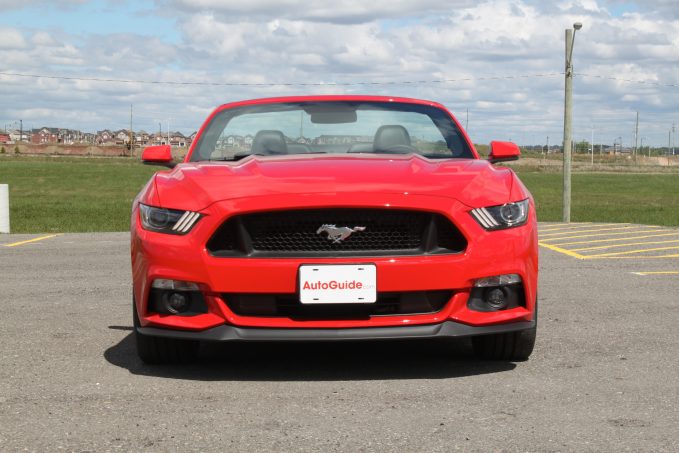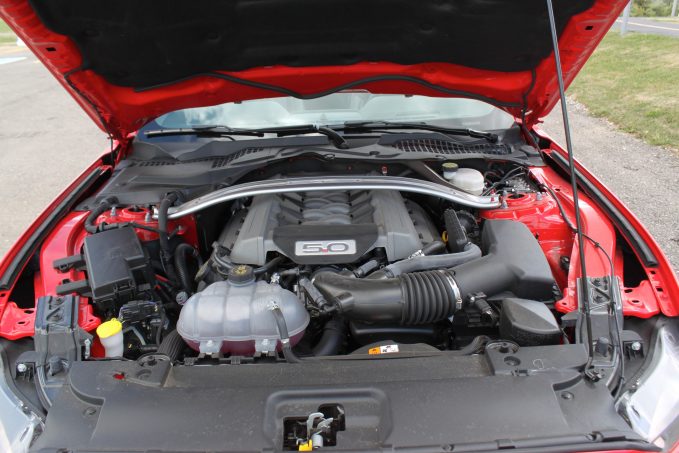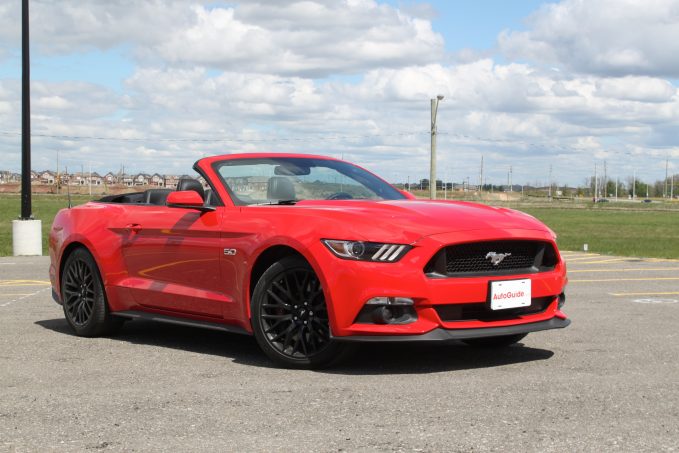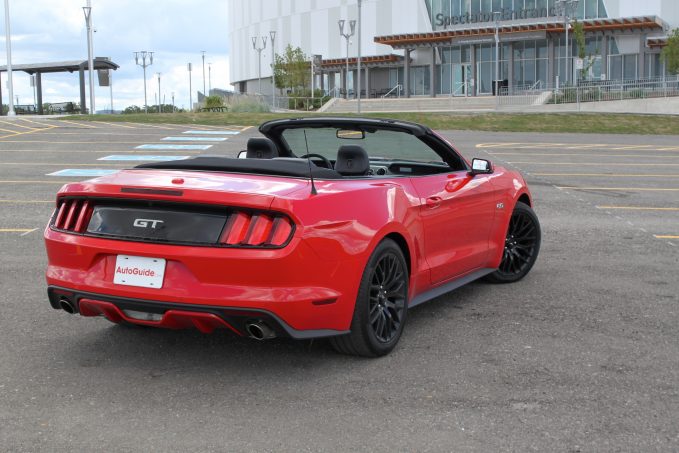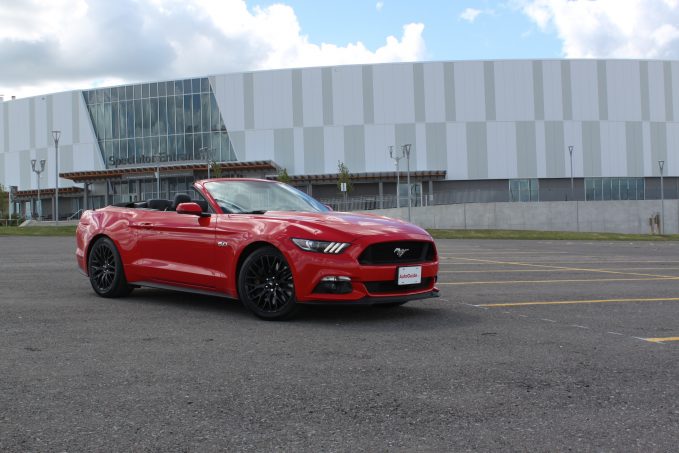There’s an interesting contrast to the imagery of the Ford Mustang Convertible and the Mustang Coupe.
You can visualize the droptop casually cruising down the Pacific Coast Highway, while you see the coupe tearing through an intersection or dragstrip. In reality, the two versions of the Mustang aren’t too different, but driving them a certain way exposes their strengths and weaknesses. And those initial visualizations are a good preview into the driving experiences both cars provide.
The 2017 Ford Mustang GT Convertible Premium we have here has red paint showcases the car’s flowing body. The droptop sports eye-catching contrasting black wheels that are wrapped in performance rubber, and the wheels also hide bigger brakes up front. At night, the side mirrors project the Mustang logo on the ground by your feet. All of this helps the Mustang looks like a go-fast, sporty car, but once you get behind the wheel, a different character begins to emerge.
One look at this convertible and your inner irresponsible teen might begin speaking to you. “Jump in, fire it up, drop the clutch, smoke those tires,” it prods. Follow your inner adolescent’s advice, though, and you might not like what you get. I certainly didn’t — the car just isn’t as hardcore as its exterior would suggest.
Jump in and the cabin is quite different than what that inner teenager would expect. It has heated and ventilated seats, a 12-speaker sound system, blind spot monitoring, reverse parking sensors, adaptive cruise control and even navigation. The Mustang is a grown up car on the inside with features and options you’re used to seeing on luxury cars from Audi or Mercedes. There’s not much that’s exciting in here.
But after slumping into the leather seats and poking the starter button, we’re reminded of what makes the Mustang Convertible so good. The 5.0-liter V8 engine roars to life and growls at an idle. With the roof and windows down, the noise is that much closer and immediate sounding.
The V8 makes an effortless 435 horsepower and 400 pound-feet of torque when fed with 93-octane fuel, and it’s a very smooth engine, although it doesn’t seem as energetic as the V8 in the Chevrolet Camaro, the Mustang’s arch enemy. It’s worth pointing out that the Camaro is slightly more fuel efficient in V8 manual trim than the Mustang, although neither are going to receive any awards from environmental advocacy groups. Coming in at just under 3,900 lbs, the car is on the heavy side, but it’s still quick, managing a sprint to 60 mph in under 5 seconds.
ALSO SEE: Ford Mustang Shelby GT350: 10 Things You Learn While Driving the Beast
To satisfy the kid within, slot the shifter into first and set off to feel the immediate rush of power the V8 provides. The shifter is notchy, perhaps a bit too much so, and the clutch is heavy with an engagement point that needs practice in order to smoothly get off the line. The first few gears are gone in a heartbeat, and the car settles down in fourth. Slot the car into sixth, and you are met with comfortable cruising.
That’s exactly what the convertible is made for. While the initial instinct is to show off the Mustang’s speed and fury, the awkward weight and size of the vehicle make it uncomfortable to truly enjoy in that manner. Sure, the steering is decent, but it provides limited amounts of feedback. The responsiveness of the chassis does seem to take a small hit in the transformation from coupe to droptop. It’s less rigid and more flexible, exhibiting cowl shake and flex when driving on rougher roads.
Slow it all down, however, and the convertible is just about perfect. The test vehicle did come with the performance package and its associated stiffer suspension, but this car begs to sport the normal, softer springs that take the urgency out of driving. Where a coupe may be the better pick for tight, winding roads and dragstrips, the convertible is the better choice for a long journey, like an aimless road trip. With the windows and roof down, wind buffeting isn’t a huge problem and you can manage a conversation with your passenger at speed without straining your voices. The roof mechanism is quick, too, going up or down in about seven seconds. Also, when the roof is down, it doesn’t restrict the rearward view in any way and eliminates most blind spots, which is handy.
As a comfy cruiser, the Mustang Convertible is ideal. It’s not all perfect, though, and some design decisions are puzzling, like the cumbersome plastic tonneau covers that have to be applied manually and then thrown in the trunk when not in use. Visibility with the roof up is also quite poor. And although Ford has included retro peekabo turn signal indicators on the hood so you can see that your indicator is on, you’ll have a tough time spotting the light on the right-hand side, due to the size and shape of the hood.
And then there’s the price. Coupes are already a tough sell, but the extra cost for a convertible is tough to justify. Our tester came to $51,065 ($59,648 CAD), though some options aren’t completely necessary, such as the $1,195 adaptive cruise control or even the $2,995 GT performance package, which seems unfit for this comfy cruiser.
The Verdict: 2017 Ford Mustang GT Convertible Review
Truly enjoying the 2017 Ford Mustang GT Convertible requires a change in expectations. It looks and sounds like an epic sports car, but it really isn’t as hardcore as it appears to be. It packs a feature-filled interior and drives comfortably and smoothly, although it does make some sacrifices in the performance department. The coupe is definitely the better driver’s car, but that doesn’t mean the convertible isn’t worthwhile. Drive it like the cross-country cruiser it is, and you’ll see why the Mustang convertible hs been around for as long as it has.







